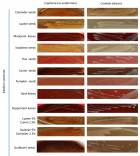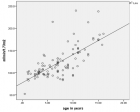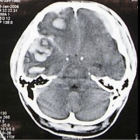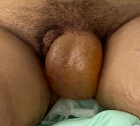Abstract
Research Article
The lifestyle modification effectiveness in reducing Hypertension in a Brazilian Community: From the epigenetic basis of Ancestral Survival to the Contemporary Lifestyle and Public Health Initiatives
Roberto Carlos Burini*, Hugo Tadashi Kano, Mariana Santoro Nakagaki, Caroline das Neves Mendes Nunes and Franz Homero Paganini Burini
Published: 12 May, 2017 | Volume 1 - Issue 1 | Pages: 010-031
High blood pressure (HBP) is a strong, independent and etiologically relevant risk factor for cardiovascular and therefore, the leading cause of preventable deaths worldwide. Hypertension has high medical and social costs. Due to its many associated complications, the use of medical services create high costs with medications which represent almost half of the estimated direct expenses. Free distribution of more than 15 medications for HyPERtension and DIAbetes (HIPERDIA program) clearly shows the important role of drugs in the Brazilian Government’s effort to tackle these two diseases. Notwithstanding, the prevalence of HBP is rising in parallel with other NCDs. It is known that HBP results from environmental and genetic factors, and interactions among them. Our ancestors were often faced with survival stresses, including famine, water and sodium deprivation. As results of natural selection, the survival pressures drove our evolution to shape a thrifty genotype, which favored/promoted energy-saving and sodium/water preservation. However, with the switch to a sodium- and energy-rich diets and sedentary lifestyle, the thrifty genotype and ancient frugal alleles, are no longer advantageous, and may be maladaptive to disease phenotype, resulting in hypertension, obesity and insulin resistance syndrome. Low-grade chronic inflammation and oxidative stress would be the underlying mechanisms for these diseases. HBP is often associated with unhealthy lifestyles such as consumption of high fat and/or high-salt diets and physical inactivity. Therefore, alternatively to medicine drugs, lifestyle and behavioral modifications are stressed for the prevention, treatment, and control of hypertension. A lifestyle modification program (LSM) involving dietary counseling and regularly supervised physical activity (“Move for Health”) has been used for decades, in our group, for NCDs primary care. Retrospective (2006-2016) data from 1317 subjects have shown the top quartile of blood pressure(142.2/88.5mmHg) differing from the lower quartile (120.6/69.2mmHg) by being older, with lower schooling, lower income and, lower physical activity and aerobic capacity. Additionally, the P75 showed higher intake of CHO, saturated fat and sodium along with lower-diet quality score with a more processed foods. They showed higher body fatness and prevalence of metabolic syndrome along with higher pro-inflammatory and peroxidative activities and insulin resistance. In this free-demand sample, the HBP rate was 51.2% for SBP and 42.7% for DBP. The rate of undiagnosed HBP was 9.8% and only 1/3 of medicated patients were controlled for HBP. After 10 weeks of LSM the HBP normalization achieved 17.8% for SBP and 9.3% for DBP with a net effectiveness of 8.5% and 2.4%, respectively. The reduction of HBP by LSM was followed by increased aerobic conditioning and reduced intake of processed foods along with decreased values of BMI, abdominal fatness, insulin resistance, pro-inflammatory and peroxydative activities. Importantly, once applied nationwide this LSM would save HBP medication for 3.1 million of hypertensives at an economic saving costs of US$ 1.47 billion a year!
Read Full Article HTML DOI: 10.29328/journal.ach.1001003 Cite this Article Read Full Article PDF
Keywords:
Blood hypertension; Epigenetics; Drug-treatment costs; Lifestyle modification-treatment
References
- Kearney PM, Whelton M, Reynolds K, Muntner P, Whelton PK, et al. Global burden of hypertension: analysis of worldwide data. Lancet. 2005; 365: 217-223. Ref.: https://goo.gl/OduA7o
- Whitworth JA. World Health Organization, International Society of Hypertension Writing Group. 2003 World Health Organization (WHO)/ International Society of Hypertension (ISH) statement on management of hypertension. J Hypertens. 2003; 21:1983-1992. Ref.: https://goo.gl/YpjuoH
- Ezzati M, Lopez AD, Rodgers A, Vander Hoorn S, Murray CJ. Comparative Risk Assessment Collaborating Group. Selected major risk factors and global and regional burden of disease. Lancet. 2002; 360: 1347-1360. Ref.: https://goo.gl/i0Bu3U
- Vasan RS, Beiser A, Seshadri S, Larson MG, Kannel WB, et al. Residual lifetime risk for developing hypertension in middle-aged women and men: The Framingham Heart Study. JAMA. 2002; 287:1003-1010. Ref.: https://goo.gl/C3dkjA
- Lewington S, Clarke R, Qizilbash N, Peto R, Collins R. Age-specific relevance of usual blood pressure to vascular mortality: a meta-analysis of individual data for one million adults in 61 prospective studies. Lancet. 2002; 360: 1903-1913. Ref.: https://goo.gl/Nm32SP
- Stamler J, Stamler R, Neaton JD. Blood pressure, systolic and dia- stolic, and cardiovascular risks: US population data. Arch Intern Med. 1993; 153: 598-615. Ref.: https://goo.gl/TGsWvn
- Picon RV, Fuchs FD, Moreira LB, Riegel G, Fuchs SC. Trends in Prevalence of Hypertension in Brazil: A Systematic Review with Meta-Analysis. PLoS ONE. 2012; 7: e48255. Ref.: https://goo.gl/fl0ZKM
- Kearney PM, Whelton M, Reynolds K, Whelton PK, He J. Worldwide prevalence of hypertension: a systematic review, J Hypertens. 2004; 22: 11-19. Ref.: https://goo.gl/q6T2pc
- Schmidt MI, Duncan BB, Mill JG, Lotufo PA, Chor D, et al. Cohort Profile: Longitudinal Study of Adult Health (ELSA-Brasil). Int J Epidemiol. 2015; 68-75. Ref.: https://goo.gl/ooYsZp
- Burini RC, Simonetti LA, Maesta N, Waib PH. Efficiency and Cost less of a Long-term Physical Exercise Program to Non-medicated Hypertensive Males. Advanced Studies in Medical Sciences. 2013; 1: 111-123. Ref.: https://goo.gl/80WAEp
- Thom T, Haase N, Rosamond W, Howard VJ, Rumsfeld J, et al. Heart disease and stroke statistics--2006 update: a report from the American Heart Association Statistics Committee and Stroke Statistics Subcommittee. Circulation. 2006; 113: e85-151. Ref.: https://goo.gl/8mRxgt
- Moreira GC, Cipullo JP, Martin JF, Ciorlia LA, Godoy MR, et al. Evaluation of the awareness, control and cost-effectiveness of hypertension treatment in a Brazilian city: populational study. J Hypertens. 2009; 27: 1900-1907. Ref.: https://goo.gl/1gRtyO
- Dib MW, Riera R, Ferraz MB. Estimated annual cost of arterial hypertension treatment in Brazil. Rev Panam Salud Publica. 2010; 27: 125-131. Ref.: https://goo.gl/y3jH5n
- Schmidt MI, Duncan BB, Silva GA, Menezes AN, Monteiro CA, et al. Chronic non-communicable diseases in Brazil: burden and current challenges. Lancet. 2011; 377: 1949-1961. Ref.: https://goo.gl/MsPCDg
- Johnson AR, Milner JJ, Makowski L. The inflammation highway: metabolism accelerates inflammatory traffic in obesity. Immunol Rev. 2012; 249: 218-238. Ref.: https://goo.gl/vPMfUy
- Young JH. Evolution of blood pressure regulation in humans. Curr Hypertens Rep. 2007; 9: 13-18. Ref.: https://goo.gl/R8g7Db
- Zhou, MS Aimei Wang, Hong Yu. Link between insulin resistance and hypertension: What is the evidence from evolutionary biology? Diabetol Metab Syndr. 2014; 6: 12. Ref.: https://goo.gl/DJE5Hk
- Straub RH. Evolutionary medicine and chronic inflammatory state-known and new concepts in pathophysiology. J Mol Med (Berl). 2012; 90: 523-534. Ref.: https://goo.gl/1SzE9M
- Machnik A, Dahlmann A, Kopp C, Goss J, Wagner H, et al. Mononuclear phagocyte system depletion blocks interstitial tonicity-responsive enhancer binding protein/vascular endothelial growth factor C expression and induces salt-sensitive hypertension in rats. Hypertension. 2010; 55: 755-761. Ref.: https://goo.gl/C8D4xU
- Machnik A, Neuhofer W, Jantsch J, Dahlmann A, Tammela T, et al. Macrophages regulate salt-dependent volume and blood pressure by a vascular endothelial growth factor-C-dependent buffering mechanism. Nat Med. 2009; 15: 545-552. Ref.: https://goo.gl/4B0Nv1
- Blackburn GL. Pasteur's Quadrant and malnutrition. Nature. 2001; 409: 397-401. Ref.: https://goo.gl/1p9hVl
- Straub RH. Concepts of evolutionary medicine and energy regulation contribute to the etiology of systemic chronic inflammatory diseases. Brain Behav Immun. 2011; 25: 1-5. Ref.: https://goo.gl/oOORDj
- Horita S, Seki G, Yamada H, Suzuki M, Koike K, et al. Insulin resistance, obesity, hypertension, and renal sodium transport. Int J Hypertens. 2011; 2011: 391762. Ref.: https://goo.gl/911IgF
- Soeters MR, Soeters PB. The evolutionary benefit of insulin resistance. Clin Nutr. 2012, 31: 1002-1007. Ref.: https://goo.gl/cOjYSp
- Neel JV, Weder AB, Julius S. Type II diabetes, essential hypertension, and obesity as “syndromes of impaired genetic homeostasis”: the “thrifty genotype” hypothesis enters the 21st century. Perspect Biol Med. 1998; 42: 44-74. Ref.: https://goo.gl/PI34Sd
- Weder AB. Evolution and hypertension. Hypertension. 2007; 49: 260-265. Ref.: https://goo.gl/ooycEF
- Neel JV. Diabetes mellitus: a "thrifty" genotype rendered detrimental by "progress"? Am J Hum Genet. 1962; 14: 353-362. Ref.: https://goo.gl/26VFzs
- Hales CN, Barker DJP. The thrifty phenotype hypothesis. Br Med Bull. 2001; 60: 5-20. Ref.: https://goo.gl/aXndOb
- Wells JC. The thrifty phenotype: An adaptation in growth or metabolism? Am J Hum Biol. 2011; 23: 65-75. Ref.: https://goo.gl/SaoWdJ
- Burini RC, de Oliveira EP, Michelin E, McLellan KCP. Epidemic obesity: An Evolutionary Perspective on the Modern Obesity Crisis to a Rationale for a Treatment. In Obesity Epidemic. 2014. Ref.: https://goo.gl/dx86lQ
- McLellan KCP, Manda RM, Sloan LA, Burini RC. Epigenetics of Glucose Metabolism and the Basis for T2DM Interventions. 2013; 51-70. Ref.: https://goo.gl/sShhhJ
- Burini RC, Kano HT, Burini FHP, McLellan KCP. Metabolic Syndrome-From the Mismatched Evolutionary Genome with the Current Obesogenic Environment to the Lifestyle Modification as a Primary Care of Free-Living Adults in a Brazilian Community. In: Jody Morton. editor. Metabolic Syndrome: Clinical Aspects, Management Options a53610-723-4nd Health Effects. Nova Science Publ. (NY) ebook.Chap.5, 2017. ISBN:978-1.
- McDougall I, Brown FH, Fleagle JG. Stratigraphic placement and age of modern humans from Kibish, Ethiopia. Nature. 2005; 433: 733-736. Ref.: https://goo.gl/llmSKu
- Frassetto LA, Schloetter M, Mietus-Synder M, Morris Jr RC, Sebastian A. Metabolic and physiologic improvements from consuming a paleolithic, hunter-gatherer type diet . Eur J Clin Nutr. 2009; 63: 947-955. Ref.: https://goo.gl/QBvAQq
- Eaton SB, Konner M. Paleolithic nutrition. A consideration of its nature and current implications. N Engl J Med.1985; 312: 283-289. Ref.: https://goo.gl/W2nFKU
- Sebastian A, Frassetto LA, Sellmeyer DE, Merriam RL, Morris Jr RC. Estimation of the net acid load of the diet of ancestral preagricultural Homo sapiens and their hominid ancestors. Am J Clin Nutr. 2002; 76: 1308-1316. Ref.: https://goo.gl/qw87WW
- Di Rienzo A, Hudson RR. An evolutionary framework for common diseases: the ancestral-susceptibility model. Trends Genet. 2005; 21: 596-601. Ref.: https://goo.gl/cfnELl
- Tsatsoulis A, Mantzaris MD, Bellou S, Andrikoula M. Insulin resistance: an adaptive mechanism becomes maladaptive in the current environment - an evolutionary perspective. Metabolism. 2013; 62: 622-633. Ref.: https://goo.gl/nnhceD
- Ebbeling CB, Swain JF, Feldman HA, Wong WW, Hachey DL, et al. Effects of dietary composition on energy expenditure during weight-loss maintenance. JAMA. 2012; 307: 2627-2634. Ref.: https://goo.gl/wxACuj
- Khoshdel AR, Carney SL, Gillies A. Circulatory syndrome: an evolution of the metabolic syndrome concept! Curr Cardiol Rev. 2012; 8: 68-76. Ref.: https://goo.gl/ifomQI
- Sell H, Habich C, Eckel J. Adaptive immunity in obesity and insulin resistance. Nat Rev Endocrinol. 2012; 8: 709-716. Ref.: https://goo.gl/cTJTGA
- Murdolo G, Piroddi M, Luchetti F, Tortoioli C, Canonico B, et al. Oxidative stress and lipid peroxidation by-products at the crossroad between adipose organ dysregulation and obesity-linked insulin resistance. Biochimie. 2013; 95: 585-594. Ref.: https://goo.gl/G3xVz3
- Kahn SE, Hull RL, Utzschneider KM. Mechanisms linking obesity to insulin resistance and type 2 diabetes. Nature. 2006; 444: 840-846. Ref.: https://goo.gl/M6HtkY
- Lumeng CN, Saltiel AR. Inflammatory links between obesity and metabolic disease. J Clin Invest. 2011; 121: 2111-2117. Ref.: https://goo.gl/FaHmJ9
- Koppaka S, Kehlenbrink S, Carey M, Li W, Sanchez E, et al. Reduced adipose tissue macrophage content is associated with improved insulin sensitivity in thiazolidinedione-treated diabetic humans. Diabetes. 2013; 62: 1843-1854. Ref.: https://goo.gl/7fcZxD
- Lumeng CN, Bodzin JL, Saltiel AR. Obesity induces a phenotypic switch in adipose tissue macrophage polarization. J Clin Invest. 2007; 117: 175-184. Ref.: https://goo.gl/0cZlnF
- Shoelson SE, Lee J, Goldfine AB. Inflammation and insulin resistance. J Clin Invest. 2006; 116: 1793-1801. Ref.: https://goo.gl/xmRXYi
- Burini RC, Torezan GA, McLellan KCP. Behavioral risk factors and effects of lifestyle modification on adults with Diabetes: A Brazilian community-based study. Emerging Issues in Medical Diagnosis and Treatment. Concept Press Ltd. 2013; 1.
- Ruiz-Nunez B, Pruimboom L, Dijck-Brouwer DA, Muskiet FA. Lifestyle and nutritional imbalances associated with Western diseases: causes and consequences of chronic systemic low-grade inflammation in an evolutionary context. J Nutr Biochem. 2013; 24: 1183-1201. Ref.: https://goo.gl/nTClWF
- Zhou MS, Schulman IH, Zeng Q. Link between the renin-angiotensin system and insulin resistance: implications for cardiovascular disease. Vasc Med. 2012; 17: 330-341. Ref.: https://goo.gl/XaT2EU
- Muniyappa R, Montagnani M, Koh KK, Quon MJ. Cardiovascular actions of insulin. Endocr Rev. 2007; 28: 463-491. Ref.: https://goo.gl/jyWEhp
- Schulman IH, Zhou MS. Vascular insulin resistance: a potential link between cardiovascular and metabolic diseases. Curr Hypertens Rep. 2009; 11: 48-55. Ref.: https://goo.gl/2MzOuW
- Lawrence J, Appel Michael W, Brands Stephen R. Sacks -Dietary Approaches to Prevent and Treat Hypertension: A Scientific Statement From the American Heart Association. Hypertension. 2006; 47: 296-308. Ref.: https://goo.gl/4c9dbx
- Mancia G, De Backer G, Dominiczak A, Cifkova R, Fagard R, et al. 2007 Guidelines for the Management of Arterial Hypertension: The Task Force for the Management of Arterial Hypertension of the European Society of Hypertension (ESH) and of the European Society of Cardiology (ESC). J Hypertens. 2007; 25: 1105-1187. Ref.: https://goo.gl/KOcH1K
- Kelley GA, Kelley KS. Progressive resistance exercise and resting blood pressure: a meta- analysis of randomized controlled trials. Hypertension. 2000; 35: 838-843. Ref.: https://goo.gl/aKf1Mt
- Whelton SP, Chin A, Xin X, He J. Effect of aerobic exercise on blood pressure: a meta-analysis of randomized controlled trials. Ann Intern Med 2002; 136: 493-503. Ref.: https://goo.gl/s86BCw
- Braith RW, Stewart KJ. Resistance exercise training: its role in the prevention of cardiovascular disease. Circulation. 2006; 113: 2642-2650. Ref.: https://goo.gl/CpdYKC
- Pescatello LS, Franklin BA, Fagard R, Farquhar WB, Kelley GA, et al. American College of Sports Medicine position stand. Exercise and hypertension. Med Sci Sports Exerc. 2004; 36: 533-553. Ref.: https://goo.gl/2CM0F6
- Williams MA, Haskell WL, Ades PA, Amsterdam EA, Bittner V, et al. Resistance exercise in individuals with and without cardiovascular disease: 2007 update: a scientific statement from the American Heart Association Council on Clinical Cardiology and Council on Nutrition, Physical Activity, and Metabolism. Circulation. 2007; 116: 572-584. Ref.: https://goo.gl/2lSE1H
- Cléroux J, Feldman RD, Petrella RJ. Lifestyle modifications to prevent and control hypertension. 4. Recommendations on physical exercise training. Canadian Hypertension Society, Canadian Coalition for High Blood Pressure Prevention and Control, Laboratory Centre for Disease Control at Health Canada, Heart and Stroke Foundation of Canada. Cmaj. 1999; 160: 21-28. Ref.: https://goo.gl/WJNAqW
- Posch K, Schmidt K, Graier WF. Selective stimulation of L-arginine uptake contributes to shear stress-induced formation of nitric oxide. Life Sci. 1999; 64: 663-670. Ref.: https://goo.gl/0ZWmlL
- Gielen S, Schuler G, Hambrecht R. Exercise training in coronary artery disease and coronary vasomotion. Circulation. 2001; 103: 1-6. Ref.: https://goo.gl/wc0ajv
- Corson MA, James NL, Latta SE, Nerem RM, Berk BC, et al. Phosphorylation of endothelial nitric oxide synthase in response to fluid shear stress. Circ Res. 1996; 79: 984-991. Ref.: https://goo.gl/HCfkMe
- Fukai T, Siegfried MR, Ushio-Fukai M, Cheng Y, Kojda G, et al. Regulation of the vascular extracellular superoxide dismutase by nitric oxide and exercise training. J Clin Invest. 2000; 105: 1631-1639. Ref.: https://goo.gl/058dBj
- Ji LL. Antioxidants and oxidative stress in exercise. Proc Soc Exp Biol Med. 1999; 222: 283-292. Ref.: https://goo.gl/W2rM60
- Hambrecht R, Wolf A, Gielen S, Linke A, Hofer J, et al. Effect of exercise on coronary endothelial function in patients with coronary artery disease. N Engl J Med. 2000; 342: 454-460. Ref.: https://goo.gl/Wntwn1
- Appel LJ, Brands MW, Daniels SR, Karanja N, Elmer PJ, et al. American Heart Association. Dietary approaches to prevent and treat hypertension: a scientific statement from the American Heart Association. Hypertension. 2006; 47: 296-308. Ref.: https://goo.gl/60lBIx
- Sacks FM, Campos H. Dietary therapy in hypertension. N Engl J Med. 2010; 362: 2102-2112. Ref.: https://goo.gl/4w4x1R
- Appel LJ, Moore TJ, Obarzanek E, Vollmer WM, Svetkey LP, et al. A clinical trial of the effects of dietary patterns on blood pressure. DASH Collaborative Research Group. N Engl J Med. 1997; 336: 1117-1124. Ref.: https://goo.gl/fplxqn
- Sacks FM, Svetkey LP, Vollmer WM, Appel LJ, Bray GA, et al. Effects on blood pressure of reduced dietary sodium and the Dietary Approaches to Stop Hypertension (DASH) diet. DASH- Sodium Collaborative Research Group. N Engl J Med. 2001; 344: 3-10. Ref.: https://goo.gl/Ua94vR
- Appel LJ, Sacks FM, Carey VJ, Obarzanek E, Swain JF, et al. Effects of protein, monounsaturated fat, and carbohydrate intake on blood pressure and serum lipids: results of the OmniHeart randomized trial. JAMA. 2005; 294: 2455-2464. Ref.: https://goo.gl/GQE7SY
- Psaltopoulou T, Naska A, Orfanos P, Trichopoulos D, Mountokalakis T, et al. Olive oil, the Mediterranean diet, and arterial blood pressure: the Greek European Prospective Investigation into Cancer and Nutrition (EPIC) study [published correction appears in Am J Clin Nutr. 2005; 81: 1181]. Am J Clin Nutr. 2004; 80: 1012-1018. Ref.: https://goo.gl/F8m1Fn
- Núñez-Córdoba JM, Valencia-Serrano F, Toledo E, Alonso A, Martínez- González MA. The Mediterranean diet and incidence of hypertension: the Seguimiento Universidad de Navarra (SUN) Study. Am J Epidemiol. 2009; 169: 339-346. Ref.: https://goo.gl/BuCbn3
- Lifton RP, Wilson FH, Choate KA, Geller DS. Salt and blood pressure: new insight from human genetic studies. Cold Spring Harb Symp Quant Biol. 2002; 67: 445-450. Ref.: https://goo.gl/zWKyzf
- Whelton PK, Appel LJ, Espeland MA, Applegate WB, Ettinger WH Jr, et al. Sodium reduction and weight loss in the treatment of hypertension in older persons: a randomized controlled Trial of Nonpharmacologic Interventions in the Elderly (TONE): TONE Collaborative Research Group. JAMA. 1998; 279: 839-846. Ref.: https://goo.gl/QmzO06
- Knowler WC, Barrett-Connor E, Fowler SE, Hamman RF, Lachin JM, et al. Reduction in the incidence of type 2 diabetes with lifestyle intervention or metformin. N Engl J Med. 2002; 346: 393-403. Ref.: https://goo.gl/0tMAZS
- Vollmer WM, Sacks FM, Ard J, Appel LJ, Bray GA, et al. Effects of diet and sodium intake on blood pressure: subgroup analysis of the DASH-sodium trial. Ann Intern Med. 2001; 135: 1019 -1028. Ref.: https://goo.gl/x1EEi4
- Bray GA, Vollmer WM, Sacks FM, Obarzanek E, Svetkey LP, et al. A further subgroup analysis of the effects of the DASH diet and three dietary sodium levels on blood pressure: results of the DASH-Sodium Trial. Am J Cardiol. 2004; 94: 222-227. Ref.: https://goo.gl/g0dKe6
- Klag MJ, Whelton PK, Appel LJ. Effect of age on the efficacy of blood pressure treatment strategies. Hypertension. 1990; 16: 700-705. Ref.: https://goo.gl/fmrdpf
- Giles WH, Kittner SJ, Hebel JR, Losonczy KG, Sherwin RW. Determinants of black-white differences in the risk of cerebral infarction: the National Health and Nutrition Examination Survey Epidemiologic Follow-up Study. Arch Intern Med. 1995; 155: 1319-1324. Ref.: https://goo.gl/Ta5DAQ
- Ayala C, Greenlund KJ, Croft JB, Keenan NL, Donehoo RS. Racial/ethnic disparities in mortality by stroke subtype in the United States, 1995-1998. Am J Epidemiol. 2001; 154: 1057-1063. Ref.: https://goo.gl/tlytjU
- Klag MJ, Whelton PK, Randall BL, Neaton JD, Brancati FL. Blood pressure and end-stage renal disease in men. N Engl J Med. 1996; 334: 13-18. Ref.: https://goo.gl/AZrgZg
- Institute of Medicine. Dietary Reference Intakes: Water, Potassium, Sodium Chloride, and Sulfate. 1st ed. Washington, DC: National Academy Press; 2004.
- Marion J. Franz-Medical Nutrition Therapy for Hypertension and Albuminuria. Diabetes Spectrum. 2006; 19: 32-38.
- Miller ER 3rd, Erlinger TP, Young DR, Jehn M, Charleston J, et al. Results of the Diet, Exercise, and Weight Loss Intervention Trial (DEW-IT). Hypertension. 2002; 40: 612-618. Ref.: https://goo.gl/y6UT40
- Appel LJ, Champagne CM, Harsha DW, Cooper LS, Obarzanek E, et al. Effects of comprehensive lifestyle modification on blood pres-sure control: main results of the PREMIER clinical trial. JAMA. 2003; 289: 2083-2093. Ref.: https://goo.gl/Sspx25
- Greenland P. Beating high blood pressure with low-sodium DASH. N Engl J Med. 2001; 344: 53-55. Ref.: https://goo.gl/Bp5FMp
- Joffres MR, Campbell NR, Manns B, Tu K. Estimate of the benefits of a population-based reduction in dietary sodium additives on hypertension and its related health care costs in Canada. Can J Cardiol. 2007; 23: 437-443. Ref.: https://goo.gl/oYHln4
- Waib PH, Papini-Berto SJ, Habermann F, Burini RC-Calcium-intake assessment in essential-arterial hypertensive patients. Rev. Saúde públ. S. Paulo. 26: 27 - 33, 1992.
- gov.br, [Internet]. Brasilia: Instituto Brasileiro de Geografia e Estatística; c2009. Available from: https://goo.gl/ZH6zaH
- Takahashi MM, de Oliveira EP, de Carvalho AL, de Souza Dantas LA, Burini FH. Metabolic syndrome and dietary components are associated with coronary artery disease risk score in free-living adults: a cross-sectional study. Diabetology & Metabolic Syndrome. 2011; 3: 7. Ref.: https://goo.gl/QlOruI
- Bach-Faig A, Berry EM, Lairon D, Reguant J, Trichopoulou A, et al. Mediterranean Diet Foundation Expert Group. Mediterranean diet pyramid today. Science and cultural updates. Public Health Nutr. 2011; 14: 2274-2284. Ref.: https://goo.gl/j5tYY0
- Brandt N. Evolutionary and Geological Timelines. 2007.
- Oliveira EP, Camargo KF, Castanho GKF, Nicola M, Portero-McLellan KC, et al. Dietary Variety is a Protective Factor for Elevated Systolic Blood Pressure.Arq Bras Cardiol. 2012; 98: 338-343. Ref.: https://goo.gl/OFLxgE
- Lastra G, Dhuper S, Johnson MS, Sowers JR. Salt, aldosterone, and insulin resistance: impact on the cardiovascular system. Nat Rev Cardiol. 2010; 7: 577-584. Ref.: https://goo.gl/uMtDiQ
- Oliveira RZ, Nogueira JL. Hipertensão arterial no município de Cianorte, estado do Paraná, Brasil. Acta Sci Health Sci. 2003; 25: 75-79. Ref.: https://goo.gl/I4Otuo
- Taylor RS, Ashton KE, Moxham T, Hooper L, Ebrahim S. Reduced dietary salt for the prevention of cardiovascular disease: a meta-analysis of randomized controlled trials (Cochrane review). Am J Hypertens. 2011; 24: 843-853. Ref.: https://goo.gl/yWlEcL
- Whelton PK, He J, Muntner P. Prevalence, awareness, treatment and control of hypertension in North America, North Africa and Asia. J Hum Hypertens. 2004; 18: 545-51. Ref.: https://goo.gl/TzdfmM
- Xu H, Barnes GT, Yang Q, Tan G, Yang D, et al. Chronic inflammation in fat plays a crucial role in the development of obesity-related insulin resistance. J Clin Invest. 2003; 112: 1821-1830. Ref.: https://goo.gl/gwj077
- Zhou MS, Schulman IH, Raij L. Vascular inflammation, insulin resistance, and endothelial dysfunction in salt-sensitive hypertension: role of nuclear factor kappa B activation. J Hypertens. 2010; 28: 527-535. Ref.: https://goo.gl/IdCQHr
Similar Articles
-
Treating Blood Hypertension in a Brazilian Community: Moving from Reactive Homeostatic Model to Proactive Allostatic HealthcareRoberto Carlos Burini*,Mariana Santoro Nakagaki,Edilaine Michelin,Franz Homero Paganini Burini. Treating Blood Hypertension in a Brazilian Community: Moving from Reactive Homeostatic Model to Proactive Allostatic Healthcare. . 2018 doi: 10.29328/journal.ach.1001006; 2: 001-016
Recently Viewed
-
Clinical and Histopathological Mismatch: A Case Report of Acral FibromyxomaMonica Mishra*,Kailas Mulsange,Gunvanti Rathod,Deepthi Konda. Clinical and Histopathological Mismatch: A Case Report of Acral Fibromyxoma. Arch Pathol Clin Res. 2025: doi: 10.29328/journal.apcr.1001045; 9: 005-007
-
Unconventional powder method is a useful technique to determine the latent fingerprint impressionsHarshita Niranjan,Shweta Rai,Kapil Raikwar,Chanchal Kamle,Rakesh Mia*. Unconventional powder method is a useful technique to determine the latent fingerprint impressions. J Forensic Sci Res. 2022: doi: 10.29328/journal.jfsr.1001035; 6: 045-048
-
Doppler Evaluation of Renal Vessels in Pediatric Patients with Relapse and Remission in Different Categories of Nephrotic SyndromeAmit Nandan Dhar Dwivedi*, Srishti Sharma, OP Mishra, Girish Singh. Doppler Evaluation of Renal Vessels in Pediatric Patients with Relapse and Remission in Different Categories of Nephrotic Syndrome. J Clini Nephrol. 2023: doi: 10.29328/journal.jcn.1001112; 7: 067-072
-
Atlantoaxial subluxation in the pediatric patient: Case series and literature reviewCatherine A Mazzola*,Catherine Christie,Isabel A Snee,Hamail Iqbal. Atlantoaxial subluxation in the pediatric patient: Case series and literature review. J Neurosci Neurol Disord. 2020: doi: 10.29328/journal.jnnd.1001037; 4: 069-074
-
Intelligent Design of Ecological Furniture in Risk Areas based on Artificial SimulationTorres del Salto Rommy Adelfa*, Bryan Alfonso Colorado Pástor*. Intelligent Design of Ecological Furniture in Risk Areas based on Artificial Simulation. Arch Surg Clin Res. 2024: doi: 10.29328/journal.ascr.1001083; 8: 062-068
Most Viewed
-
Evaluation of Biostimulants Based on Recovered Protein Hydrolysates from Animal By-products as Plant Growth EnhancersH Pérez-Aguilar*, M Lacruz-Asaro, F Arán-Ais. Evaluation of Biostimulants Based on Recovered Protein Hydrolysates from Animal By-products as Plant Growth Enhancers. J Plant Sci Phytopathol. 2023 doi: 10.29328/journal.jpsp.1001104; 7: 042-047
-
Sinonasal Myxoma Extending into the Orbit in a 4-Year Old: A Case PresentationJulian A Purrinos*, Ramzi Younis. Sinonasal Myxoma Extending into the Orbit in a 4-Year Old: A Case Presentation. Arch Case Rep. 2024 doi: 10.29328/journal.acr.1001099; 8: 075-077
-
Feasibility study of magnetic sensing for detecting single-neuron action potentialsDenis Tonini,Kai Wu,Renata Saha,Jian-Ping Wang*. Feasibility study of magnetic sensing for detecting single-neuron action potentials. Ann Biomed Sci Eng. 2022 doi: 10.29328/journal.abse.1001018; 6: 019-029
-
Pediatric Dysgerminoma: Unveiling a Rare Ovarian TumorFaten Limaiem*, Khalil Saffar, Ahmed Halouani. Pediatric Dysgerminoma: Unveiling a Rare Ovarian Tumor. Arch Case Rep. 2024 doi: 10.29328/journal.acr.1001087; 8: 010-013
-
Physical activity can change the physiological and psychological circumstances during COVID-19 pandemic: A narrative reviewKhashayar Maroufi*. Physical activity can change the physiological and psychological circumstances during COVID-19 pandemic: A narrative review. J Sports Med Ther. 2021 doi: 10.29328/journal.jsmt.1001051; 6: 001-007

HSPI: We're glad you're here. Please click "create a new Query" if you are a new visitor to our website and need further information from us.
If you are already a member of our network and need to keep track of any developments regarding a question you have already submitted, click "take me to my Query."

















































































































































